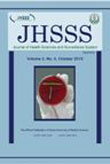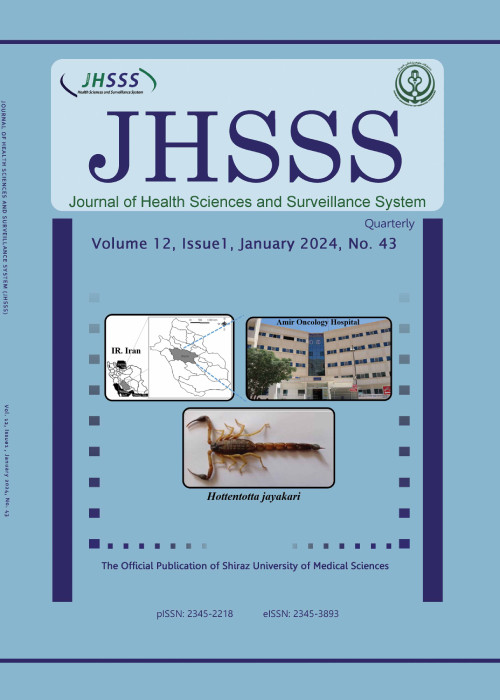فهرست مطالب

Journal of Health Sciences and Surveillance System
Volume:3 Issue: 4, Oct 2015
- تاریخ انتشار: 1394/07/21
- تعداد عناوین: 8
-
-
Page 128BackgroundThe consumption of healthy food is considered as an essential need to devoid the physical, chemical, and biological hazards. The importance of this issue is more conspicuous in places such as hospitals where people with somehow compromised immune systems are under treatment. Therefore, this research aimed to evaluate the microbiological quality of food contact surfaces in a kitchen in one of the hospitals of Shiraz University of Medical Sciences.MethodsIn the present study, samples were taken from 48 food contact surfaces according to ISO 18593:2004(E) and placed into the bags containing diluting solution; they were then transferred to the laboratory for microbial analysis in the cold chain. The microbial analysis was carried out according to ISO 4833-1:2013 and BS ISO 4832:2006 for enumeration of total bacterial count and coliform.ResultsBased on the results presented here, 39.6% and 85.7% of the samples showed acceptable contamination with regard to the enumeration of total bacterial and coliform count. Besides, 18.2% and 72.7 % of work surfaces groups (cutting board, table, and hand) showed acceptable contamination with regard to the enumeration of total bacterial count and coliform in comparison to the standards. Furthermore, 45.9% and 89.2% of other surfaces showed acceptable total bacterial and coliform count, respectively.ConclusionThe results showed that safe management of the kitchen, education of the staff and also improvement of the equipment used are necessary.Keywords: Total bacterial count, Coliform, Food contact surfaces, Hospital
-
Page 133BackgroundCancer is the third cause of death in Iran and its incidence is rising alarmingly. However, a study reported that Kohgilooyeh and Boyerahmad (a small province in Iran) seems to have substantially lower incidence rate of cancer compared to the other parts of the country. This study is conducted to investigate the epidemiological features of cancer regarding three key factors (sex, age and sites of cancer).MethodsThe data collection strategy for this study is similar to the Iranian National Cancer Registry programme.ResultsFor the study period (2007-2009), 660 eligible cases of cancer were reported to Kohgilooyeh and Boyerahmad’s National Cancer Registry provincial office with average annual age standardized rate (ASR)=64.58 per 100000 (74.95 per 100000 and 45.85 per 100000 for men and women, respectively). The five leading primary cancer sites for both genders in K and B are skin, stomach, blood, bladder and breast. Regarding the sex specific incidence rates of cancer, the skin, stomach, bladder, blood and prostate in men and the skin, breast, stomach, blood and ovary in women are suggested to be the five leading sites of cancer. The trends of age-site specific incidence rates of skin cancer obtained in the current study are essentially similar to what is expected.ConclusionCompared to the national and international figures, significant differences were found in the age-site specific rates of cancer in the province.Keywords: Cancer incidence, Age distribution, Gender
-
Page 139BackgroundRecently, there has been a great concern about the consumption of dyes because of their toxicity, mutagenicity, carcinogenicity, and persistence in the aquatic environment. Reactive dyes are widely used in textile industry. Advanced oxidation processes are one of the cost-effective methods for the removal of these dyes. The main aims of this study were determining the feasibility of using Fenton process in removing Reactive Red 198 (RR-198) dye from aqueous solution and determining the optimal conditions.MethodsThis is a cross-sectional study conducted at a laboratory scale. A total of 69 samples were considered and the effect of pH, Fe (II) concentration, H2O2 concentration, initial dye concentration and reaction time were investigated.ResultsAccording to the results, a maximum removal efficiency of 92% was obtained at pH of 3 and the reaction time of 90 min; also, the concentration of Fe (II), H2O2, initial dye concentration were 100 mg/L, 50 mg/L, and 100 mg/L, respectively. The results revealed that by increasing the concentration of Fe (II), H2O2 and initial dye, the removal efficiency was increased.ConclusionsThe results showed that Fenton process could be used as a cost-effective method for removing RR-198 dye from textile wastewater efficiently.Keywords: Reactive Red 198, Waste water, Fenton process, Dye removal
-
Page 146BackgroundUse of glucosamine as an alternative treatment for osteoarthritis is becoming more frequent, including in those who have diabetes at the same time. The results from in vitro and animal studies propose that glucosamine may inversely affect glucose metabolism. However, the recommended dose of oral glucosamine in healthy people or diabetics did not have such effects consistently. The aim of the present study was to assess the effect of glucosamine on glycemic control and insulin resistance in type 2 diabetic patients.MethodsFifty-four patients with type 2 diabetes participated in this randomized, double-blind, placebo controlled study. The participants were assigned to receive 1500 mg glucosamine hydrochloride or placebo for 12 weeks. After determining their baseline characteristics, body mass index and dietary intake components, fasting blood glucose and fasting insulin were measured at weeks of 0, 8, and 12. Indices of insulin function including quantitative insulin sensitivity check index (QUICKI) and homeostasis model assessment of insulin resistance (HOMA-IR) were calculated by specific formulas. Independent t-test and general linear model repeated measures were used to analyze the data.ResultsIn the glucosamine group, the means of fasting blood glucose and insulin were 107.31±24.07 mg/dl and 8.75±4.37 μu/ ml, respectively at baseline, which reached 112.38±31.50 and 9.10±4.17 at week 12. In the placebo group, the mean for fasting blood glucose and insulin were 103.84±24.15 and 9.79±4.02 at the beginning of the study, which reached to 111.40±26.43 and 8.58±3.68 at week 12. The results showed that there were no significant differences in fasting blood glucose, insulin, HOMA-IR and QUICKI indices at all the studied time points (weeks of 0, 8 and 12) within or between the groups.ConclusionTwelve weeks of a normal recommended dose of glucosamine supplements may not have adverse effects on glycemic control and insulin resistance in type 2 diabetic patients.Keywords: Diabetes mellitus, Glucosamine, Blood glucose, Insulin resistance
-
Page 153BackgroundHigh amount of heavy metals in sludge is one of the major obstacles to its use on farms. The present study aimed to investigate the possibility of leaching heavy metals from wastewater sludge by Fenton method and determine the optimum level of parameters, such as iron, hydrogen peroxide, time, and pH for Fenton reaction.MethodsThe effects of various parameters, such as pH (2-9), hydrogen peroxide concentration (0.5-6 g/l), Fe concentration (0.5-4 g/l), and leaching time (5-60 min), were studied.ResultsThe results showed that the optimal condition for leaching of heavy metals occurred at pH of 2-3, hydrogen peroxide concentration of 3 g/l, iron concentration of 2 g/l, and leaching time of 15 min. Under these optimal conditions, 92% of Zn, 100% of Cd, 100% of Pb, and 80% of Cu were leached from the wastewater sludge.ConclusionsFenton method can leach heavy metals from wastewater sludge through decomposition of organic materials at H2O2/Fe ratio of 1.5:2.Keywords: Fenton, Heavy metals, Hydrogen peroxide, Wastewater sludge
-
Page 160BackgroundCutaneous Leishmaniasis (CL) is endemic in many parts of Iran. This study was conducted to investigate the fauna and some biologic factors of sand flies and detect CL vector(s) in Kharameh district which is one of the most important foci of the disease in Fars province, southern Iran.MethodsTo identify the fauna, a total of 1549 sand flies were collected from April 2014 to March 2015. To determine the monthly activity, sand flies were collected from indoor and outdoor areas of the lowland and the highland regions.ResultsTen species of phlebotomine (four Phlebotomus spp. And six Sergentomyia spp.) were identified and Phlebotomus papatasi was the dominant species (53.45%). To determine the sand flies naturally infected by Leishmania spp., 188 female sand flies (145 P. papatasi, 29 P. sergenti, and 14 P. alexandri) were subjected to polymerase chain reaction (PCR) assay. Two (13.16%) specimens of P. papatasi were found to be positive for Leishmania major.ConclusionsTo the best of our knowledge, this is the first PCR detection of L. major within naturally infected P. Papatasis and fly as the main vector in this region of south Iran.Keywords: Sand flies, Fauna, Monthly activity, Kharameh, Iran


